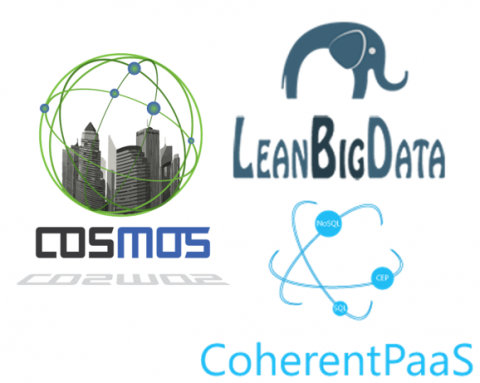COSMOS NTUA Hackathon results available for smart cities and events! Congrats to the winners and all participants!
COSMOS NTUA Hackathon results available for smart cities and events! Congrats to the winners and all participants!

COSMOS in collaboration with LeanBigData (leanbigdata.eu) and CoherentPaaS (coherentpaas.eu) organized an open participation Hackathon during which the participants were given the opportunity to create new applications focused on the Internet of Things, Smart Homes and Smart cities concepts, using the projects’ tools. All the tools that were available as well as instructions and details regarding their use can be found at https://github.com/COSMOSFP7?tab=repositories. Indicatively, these tools included a Case-based Reasoner, Privelets and NodeRED flows.
A warm-up event which took place on Monday 23rd of May, at the multimedia room of the central library of NTUA marked the beginning of the Hackathon. During this event, the organizers presented the basic functionalities of the projects, the scenarios on which the participants would compete and the tools that could be used for the Hackathon.
In total, 9 teams of 1-3 people participated in the Hackathon and implemented small projects which were presented in front of the judges on Friday 24th of July at NTUA. The participating individuals and teams made a short presentation describing the scenario that was implemented or extended, the procedure that was followed and the final results and submitted their source code.
Taking under consideration several criteria like the originality of ideas, the level of implementation, the use of the tools provided and the completion of several basic and extra challenges announced beforehand, three winning teams were chosen. Indicatively, a short description of the corresponding three projects can be found below:
1st Team: An application for assisting Smart Home users with hearing impairment
- The team: Mpouras John, Theodore Florakis, George Fragkos
- App description: The purpose of the app is to capture (via a microphone) and identify environment sounds (like telephone ringing, doorbell, fire-alarm, knocking-door and crying baby), analyse and understand their purpose and notify via twitter posts the person involved (e.g. “Please open your door! The bell is ringing!”, “Attention! A fire-alarm is ringing”). The participants utilized test sounds and applied an analysis of their choice and investigated potential matchmaking and generalization aspects for sound categorization. The app was tested in real world circumstances were real sounds from the houses of the participants were recorded from their mobile phones using an android app (Smart Voice Recorder). The results that were produced were the expected ones for all of the sounds.
- Tools used: The main tool used was the Planner that was given to reason on the knowledge base in which the dominant-harmonic frequencies for each sound category were stored. The knowledge base was created using the Protege tool and stored in RDF /XML file format as an ontology. The synthesis of the above as a web service as well as the twitter post was implemented via Node-RED.
- Feedback: The Planner was described as “easy to use, easy to set up, trust-worthy, with fast results, and transferable code”. A recommendation that was made was to create an easy-to-use interface for inserting the data and building fast and automatically the initial Case Base. Node-RED was described as “a very useful and easy to use tool which helped us to synthesize our application as a web-service and much more”.
2nd Team: A social application for parking
- The team: John Androulidakis, George Theodorakis
- App description: Through this application users can search for empty parking slots in their current location. The end-users can post empty parking slots from their current position using twitter (#nodeProjectParking message) with a comment of the slot (e.g. slot for small car/ many positions for free all day). When they want to search for an empty parking slot, they can use the parking application on their phone (or computer) and get the nearest available parking slots with the comments about them. The input given is the address near which the end-user wants to park, the radius of search and the desired time window (e.g. empty slot in the last hour for more up-to-date results). Finally, the user can select the slot he parked and delete it. The user can comment about the application.The app administrators can manage manually the application with Node-RED and receive comments from the end-users, which are processed with the LeanBigDataSentiment in order to categorize them and improve the application in the future.
- Tools used: Node-RED was used for creating the server side of the application, Twitter API for Node-RED was used for the communication with twitter, Google API for Node-RED was used for using various Google services(e.g. GeoCode) and MongoDb API was also used. Angular 2.0 MVC framework was used for building the mobile application. The Sentiment Analysis tool from the LeanBigData project was used for the comments classification for further improvements.
- Feedback: Both Node-RED and Sentiment Analysis were evaluated as useful, easy-to-use tools.
3rd Team: A public transportation application
- The team: Periklis Chatzidiakos
- App description: An application focusing on providing a meaningful combination of information about: a) present and future public transportation strikes (data from www.apergia.gr), the estimated time of arrival of busses that pass from a chosen bus stop (data from telematics.oasa.gr), entertainment places (e.g bars, cafes, restaurants) near a location the user defines. A simple web user interface is provided in order to easily access some of the gathered information.
- Tools used: The only tool used was Node-RED.
- Feedback: “Node-RED is a fine, quick-development tool. The provided Node-RED flows from the organizers were really helpful.”
